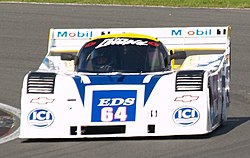Intrepid RM-1
 |
|||||||||
| Category | IMSA GTP | ||||||||
|---|---|---|---|---|---|---|---|---|---|
| Constructor | Pratt & Miller | ||||||||
| Designer(s) | Bob & Bill Riley | ||||||||
| Technical specifications | |||||||||
| Chassis | Carbon fibre and aluminum honeycomb composite monocoque with steel roll cage | ||||||||
| Suspension (front) | Double wishbone with pushrod-actuated inboard spring/damper | ||||||||
| Suspension (rear) | Double wishbone with pushrod-actuated bellhousing-mounted spring/damper | ||||||||
| Length | 189 in (480.1 cm) | ||||||||
| Width | 78 in (198.1 cm) | ||||||||
| Height | 41 in (104.1 cm) | ||||||||
| Wheelbase | 110 in (279.4 cm) | ||||||||
| Engine | Chevrolet 7.2 L (439 cu in) V8 Naturally aspirated mid-mounted | ||||||||
| Transmission | Hewland 5-speed + reverse manual | ||||||||
| Weight | 1,800 lb (816 kg) | ||||||||
| Tyres |
Goodyear Eagle BBS wheels, 13x17 front, 15x17 rear |
||||||||
| Competition history | |||||||||
| Notable entrants | MTI Racing Prototype Technology Group Wayne Taylor Racing |
||||||||
| Notable drivers |
|
||||||||
| Debut | 1991 Toyota Camel Grand Prix of Palm Beach | ||||||||
|
|||||||||
| Teams' Championships | 0 | ||||||||
| Constructors' Championships | 0 | ||||||||
| Drivers' Championships | 0 | ||||||||
The Intrepid RM-1 (also known as the Intrepid GTP or Chevrolet Intrepid) is a sports prototype racing car designed in 1991 by Bob and Bill Riley and built by Pratt & Miller to IMSA GTP specifications. Powered by a Chevrolet V8 engine, it was campaigned variously by Jim Miller, Prototype Technology Group and Wayne Taylor in the IMSA Camel GT from 1991 through 1993. Though it won only one race in its three seasons of competition, the shovel-nosed Intrepid was notable for the extreme—and at one point, disastrous—levels of downforce it generated, giving it the highest cornering speeds of any prototype of its era. The car's development was set back by a devastating 1991 crash at Watkins Glen that critically injured driver Tommy Kendall, and the program never fully recovered.
Jim Miller originally hired Bob Riley and his son, Bill, in 1990 to design improvements to his Spice Engineering-built GTP car. However, Miller was unsatisfied with campaigning customer prototypes—"If you're going to be competitive you had to have a unique car," Miller said. Bob had earlier developed conceptual plans for a high-downforce, rear-engined GTP car as a follow-on to his mid-1980s Ford Mustang GTP design, and Miller agreed to fund the design and construction of what became known as the Intrepid RM-1. The chassis was constructed by Pratt & Miller, an engineering firm formed by a partnership between Miller and Gary Pratt.
In designing the Intrepid, Bob Riley considered developing maximum downforce as the primary goal rather than minimizing aerodynamic drag, which meant sacrificing the car's top speed in favor of increasing its cornering speed. He viewed this tradeoff as a favorable one given the relatively slow and twisting nature of most American road courses compared to European circuits. Other teams viewed this effort skeptically, as traditionally drag is viewed as the enemy of a racing car designer. As a result, Pratt recalled, "The Intrepid had quite a bit of a different look than anybody else out there." Also unlike other IMSA GTP designs, the Intrepid was never intended to be suitable for endurance races such as the 24 Hours of Daytona or 12 Hours of Sebring. This was an intentional decision by Riley to sacrifice durability and longevity in favor of outright speed—as a result, in its three seasons of competition, the Intrepid was never entered in a 24-hour race and only once was entered in the 12 Hours of Sebring, in 1992.
...
Wikipedia
